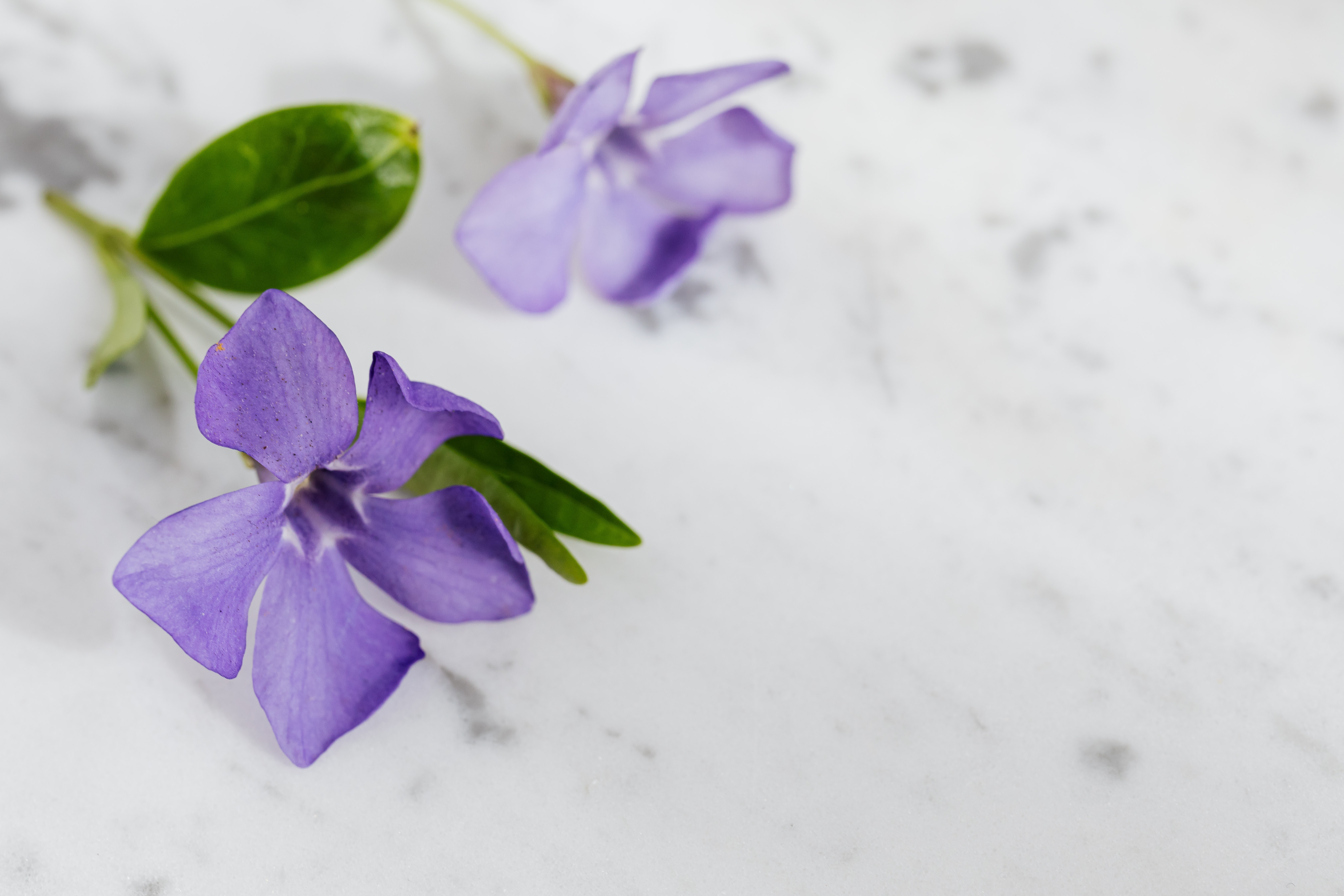Forgiveness is the fragrance that the violet sheds on the heel that has crushed it. ~ Mark Twain
Viola odorata—a cooling, healing herb that is gentle and soothing for the lungs and digestive system.
As the spring growth begins once again and the green ground begins to establish itself, we may be charmed by the emergence of the sweet violet or Viola odorata.
The English herbalist, Nicholas Culpeper, associated sweet violet with the planet Venus and described it as “mild nature and no way hurtful.”1 He also said that “all the violets are cold and moist, and are used to cool any heat or distemperature of the body, either inwardly or outwardly.”2
Viola may be used as a gentle lymphatic or blood purifier to help our bodies wake up to the spring season. Just as the flow of sap in the trees begins to move as the temperature warms, we can help our bodies wake up from the cold nest of winter and move any stagnation by gently stimulating our lymphatic fluids.
These delightful plants are both nutritive food and medicine. The medieval mystic, Hildegard of Bingen said “the violet is mainly of moderate heat and it grows by the sweetness and gentleness of the air.”3 Hildegard understood the medicinal virtues of Viola odorata. The herb was grown in medieval kitchen gardens as well as Physic or medicinal gardens. Violets were praised for their fragrance as well as their rich purple colour.
HERBAL PROFILE: Viola odorata
Earlier names: Viola purpurea, Viola glancia
In Greek: ion agrion
The aromatic principle is known as ionine or irone
Family: Violaceae
Common Name: Sweet Violet
Parts Used: Leaves, flowers, and their oil
Taste: Sweet, mucilaginous, cool, moist, slightly salty
Energy: Cooling, moistening
Active constituents:
- Phenolic glycosides, gaultherin, violutoside (salicylic acid methyl ester)
- Saponins—myrosin, violin
- Flavonoids—rutin, violarutin
- An alkaloid, odoratine
- Aromatic substances—ionine, irone
- Mucilage
- Minerals—calcium and magnesium
Herbal Actions:
- Respiratory demulcent
- Respiratory expectorant
- Immune lymphatic
- Anti-inflammatory
- Urinary diuretic
System tropism:
- Respiratory: Mucous membranes
- Immune: Lymph
Plant description:
Native to Asia, North Africa, and Europe. It was introduced elsewhere, on damp calcareous soils, shady woodland, scrubland, hedgerows, and wood clearings up to 1000 m2.
Viola is a small, perennial creeping plant that grows up to 15–25 cm tall and 30–45 cm across and is spread by flagelliform runners. The heart-shaped leaves are flat fragments of dark green, with slender stems. The flowers are attractive and scented, about 2 cm wide, with small purple petals often still connected to green sepals and a white flower base. They appear in mid- to late- spring.
HISTORY
Viola is the Latin form of the Greek name “Ione.” There is a myth that violets were created for Io, the beloved of Zeus, to honour her after he changed her into a white heifer for fear of Hera’s jealousy.4
Notable Facts
This sweet-scented violet symbolized shyness and modesty; in medieval times, violet symbolized Christ’s humility.5 In monastery gardens, it was cultivated extensively to protect against all forms of evil. Pliny, an ancient Roman naturalist, said that Viola-induced sleep strengthened the heart muscles and calmed anger.6
Viola was cultivated for over 2000 years as a colouring agent for drinks and syrups, and as a source of perfume. It was most popular at the turn of century in England and is still grown for these uses in Europe, although ionine was synthesized in 1893.

MEDICINAL PROPERTIES & INDICATIONS
Respiratory System
Soothing for the lungs and the digestive system.
The saponins and mucilage in Viola help to loosen and clear mucous from the respiratory tract, relieving harsh, irritating coughs. A syrup made with Viola (see recipe at the end of this article) is a famous remedy for soothing children’s coughs. Consider this herb when there’s a need to cool and soothe the lungs. The mucilage in the plant may also help soothe the intestines and stomach. This syrup has a long history of helping constipation in children as a gentle laxative as well.
The cooling properties of Viola act whenever there is heat and inflammation present; it can relieve headaches and migraines that have a hot nature.
Indications:
- Coughs, especially for bronchitis
- For upper respiratory catarrh, mouth, and throat infections
Lymphatic System
Viola works both internally and externally to move stuck or sluggish lymph. As a gentle lymphatic, it can help to stimulate flow while reducing inflammation in the process.
An infused oil of Viola is a lovely way to gently release lymphatic congestion. The oil is often used on the breasts to resolve swellings and hardness. Since the breasts are abundant in lymphatic tissue, Viola can be of great assistance in cases of fibrocystic breast conditions, plugged milk ducts, and mastitis.7 When more lymphatic action is indicated at our clinic, we combine Viola with Phytolacca decantra and castor oil.
Due to its mild, soothing action, the oil may also be used as a massage oil for when a person (of any age) feels like they are getting sick and have swollen glands.
Accompanied by other herbs, it may be used for eczema, rheumatism, and urinary tract infections.
Indications:
- Swollen glands
- Fibrocystic breasts
- Sore muscles
- Lymphatic congestion
Contraindications & Safety
Large doses of the root are emetic or purgative.
Preparations & Applications
Dosage: Tincture (1:5):
- Adult: 1–2 ml TID
- Child: ¼–½ ml TID
Tea (Infusion): 1 tsp of herb, 8 oz hot water; infuse for 10–15 minutes
- Adult: 1 cup TID
- Child: ¼–¾ cups TID
Recipe: Royal Violet Simple Syrup
Adapted from The Healing Garden8 and Learning Herbs (by Rosalee de la Forêt)9
Ingredients
- 1½ c violets (Viola odorata) that are loosely packed, with green leaves, stems, and calyx removed (if large)
- 2 c filtered and boiled water, cooled for 5 minutes
- ¼ c honey (or sweetener of choice—some say 1 c organic white sugar to make the mixture brilliant purple)
- 1–3 drops of organic lemon juice
Instructions
- Place the violet flowers in a 1 L glass mason jar.
- Fill the jar with filtered boiled water from the kettle after cooling for a few minutes.
- Stir well and cover.
- Let the infusion sit for 30 minutes (or longer) until the colour has drained from the flowers, leaving a blue-coloured tea.
- Strain into a non-metallic vessel.
- At this stage, you may add a few drops of lemon juice to make the colour change to purple. If you add more lemon juice, the colour may change to magenta or pink.
- Add honey or another sweetener of choice. Stir well.
May be stored in the fridge for a few days. To keep longer, add an equal volume of sweetener to water (i.e., 2 c water, 2 c sweetener).
The Violet syrup may then be added to lemonade or sparkling water for a refreshing spring drink. It may also be a great addition to cocktails.
For references visit ecoparent.ca/TWF/SPRING23
You May Also Like: Ashwagandha: Essential in Your Parental Toolbox for Managing Stress, Inula Helenium for Respiration & Digestion, Passionflower: Natural Medicine for Body and Soul.





